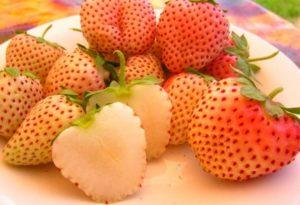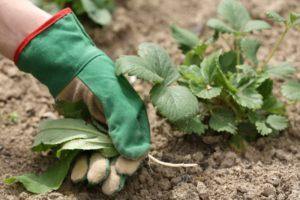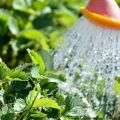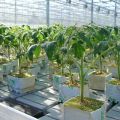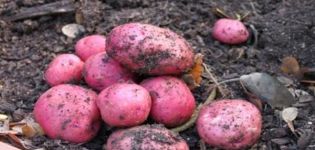Rules for growing and caring for strawberries using Dutch technology
Growing strawberries using Dutch technology, you can get several harvests of this thermophilic crop in one year. The popularity of this method is also due to the fact that the described method requires less time and labor. Dutch technology provides two options for planting and germinating strawberries.
The principle of the method
The essence of the Dutch technology boils down to the following: optimal conditions are created for the germination of strawberries to ensure the maximum possible yield. To do this, the gardener continuously plants new seedlings after the previous one has borne the first fruits.
The method involves planting the culture in separate containers:
- flower pots;
- bags;
- boxes;
- pallets.
For maximum fruiting, it is necessary to ensure a constant flow of nutrients to the bushes. This will require the organization of continuous drip irrigation with a mixture of trace elements.
Basically, greenhouse strawberry germination is used according to Dutch technology. This option allows you to harvest all year round. However, it can be grown without greenhouses. In the second case, it will also be necessary to provide certain conditions in which the plant can grow quickly and harvest early.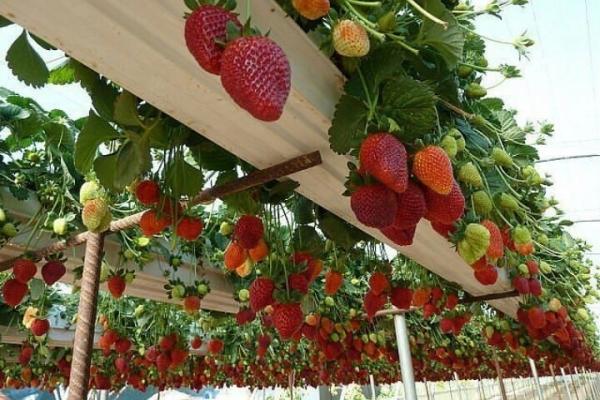
Varieties for cultivation
Under the terms of Dutch technology, strawberries are grown in a closed (restricted) environment. Therefore, remontant varieties are used to grow crops in this way. In addition, the plant must be a self-pollinating species, otherwise it will be impossible to get a crop. The following varieties meet these conditions:
- Darselect. Produces an early harvest and is able to grow in low light conditions. The fruits of the plant are large. From one bush, you can collect up to a kilogram of berries.
- Selva. The variety, in the absence of frost, bears fruit throughout the year. Subject to the rules of cultivation, one bush gives up to 1.5 kilograms of fruit.
- Sonata. The variety belongs to the early maturing varieties. Each bush also yields up to 1.5 kilograms of berries.
Remontant varieties suitable for Dutch technology include Queen Elizabeth II, Fresca and Albion.
Main advantages and disadvantages
The benefits of Dutch technology include:
- early and stable harvest all year round;
- strawberries are not susceptible to diseases and pests;
- berries have a marketable appearance and are distinguished by pleasant taste;
- the technology allows you to grow crops in small areas;
- the method is suitable for germinating a culture at home.
The main disadvantage of this method is that drip irrigation will be required for year-round ripening. In addition, it is necessary to create and maintain a certain microclimate, as well as constantly acquire planting material.

Planting method
Dutch technology provides two options for growing strawberries: horizontal and vertical. Each of these approaches has its own advantages and disadvantages. At the same time, both cultivation options allow you to get a stable and plentiful harvest.
Vertical
This method involves vertical (one above the other) arrangement of boxes or other containers with strawberries. This cultivation option is chosen for small areas. In particular, the vertical method is suitable for an apartment. The main disadvantage of this method is the difficulty of providing constant drip irrigation: it is necessary to create non-standard structures for supplying water and nutrient mixture.
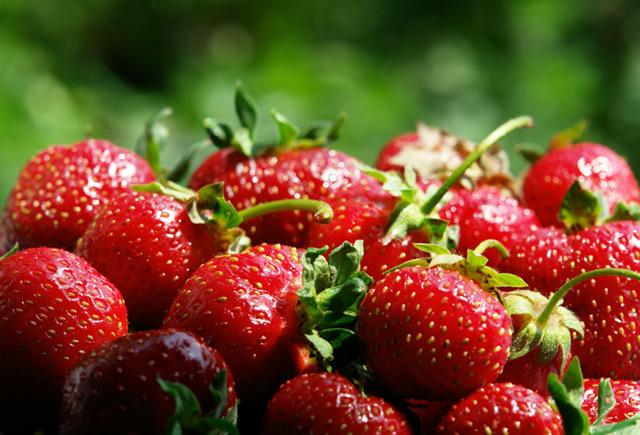
Horizontal
This option is suitable for greenhouse crop cultivation, as it involves the installation of containers with strawberries parallel to the floor and to each other. This method is considered the most convenient due to the fact that to organize drip irrigation, it is enough to lay a hose with holes and a plug at the end between the containers. Horizontal cultivation is not suitable for small spaces.
The process of growing strawberries in the Dutch way
Growing according to Dutch technology requires compliance with several important nuances, on which the planting yield depends:
- Containers of shallow depth. For this, polypropylene pipes, boxes, containers and flower pots are suitable.
- Seedlings should not be placed close to each other, trying to save free space. This will reduce the size of the berries.
- The potting soil must be disinfected before filling the pots with soil. For this, a heated solution of potassium permanganate is used. Peat must be steamed before being added to the soil.
- Strawberries give a good harvest, provided that mineral fertilizers are applied with a sufficient amount of useful trace elements.
- Due to the fact that according to Dutch technology it is necessary to regularly change plants, it is recommended to prepare planting material in advance.
- For the winter, strawberries grown in the open field do not need to be covered. At the same time, before the onset of spring, it is necessary to prepare new planting material by placing the seedlings in the refrigerator.
- In case of insufficient light, it is necessary to install UV lamps next to the strawberries.
According to the terms of Dutch technology, after harvesting, it is necessary to remove the plant from the soil and place new seedlings. This procedure is, on average, repeated every two months.
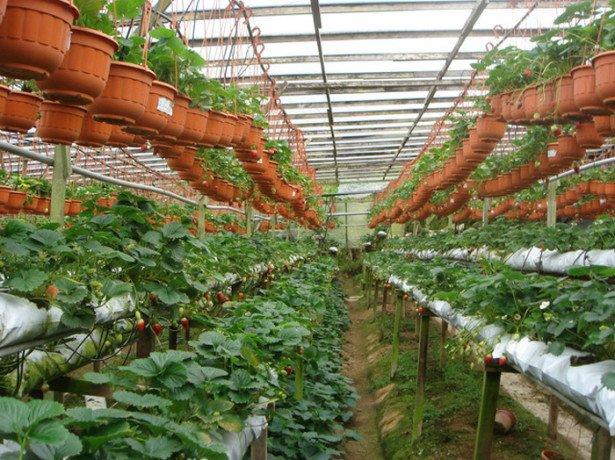
For the rest, cultivation using Dutch technology does not differ from other methods: when planting seedlings at the bottom, drainage (expanded clay or other) is filled up with a layer of up to two centimeters, and the roots of the strawberries are straightened and, if necessary (if the rhizomes are bent), are cut off. The plant requires constant watering and regular feeding.
Priming
For growing strawberries, it is not recommended to use the soil collected on the site. Such soil contains pathogens, due to which the plant will die. For strawberries, a store-bought potting soil mixture used for growing indoor plants is suitable.
It is important that this soil is sufficiently loose and has a high moisture capacity.
Harvesting and growing seedlings
Seedlings can be constantly purchased in stores. However, if the Dutch growing method is used, use your own seedlings.
To get seedlings, you need to plant one bush in open ground. After the onset of the first frost, it is necessary to dig out the strongest plants and place them in a dry room with an air temperature of 0-2 degrees. Then, a day before planting in prepared containers, these seedlings are kept in a room at +18 degrees.
The second option is convenient in that a mustache is used for planting, growing from the main bush. This material, also after cutting, is first kept indoors at a temperature of 0-2 degrees. Then the seedlings are placed in a container with any potting soil and left in this form for 1 month in a shaded area. Further, for one week, the planting material is exposed in a well-lit place. At the end of this period, the seedlings can be distributed into containers.
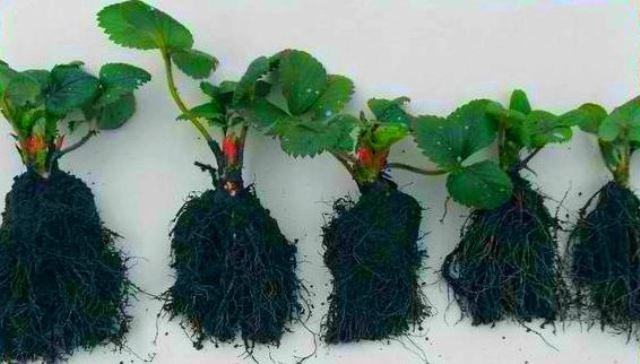
Lighting
Planting strawberries in greenhouses is considered the best solution. In this case, the plant will receive enough light. In the cold season, you will need to organize artificial lighting. Ultraviolet lamps must be placed at least 1 meter away from bushes.
Irrigation and feeding system
In order to organize drip irrigation, you can lay garden hoses along the beds of strawberries with small holes cut out and a plug at one end.
To feed the plant, use a mixture of 10 liters of water, 80 grams of ammonium nitrate and 10 grams of potassium chloride. Such a composition in the amount of 100 milliliters, by means of drip irrigation, must be fed under each bush. Top dressing is applied 2 weeks after planting and during the flowering period.
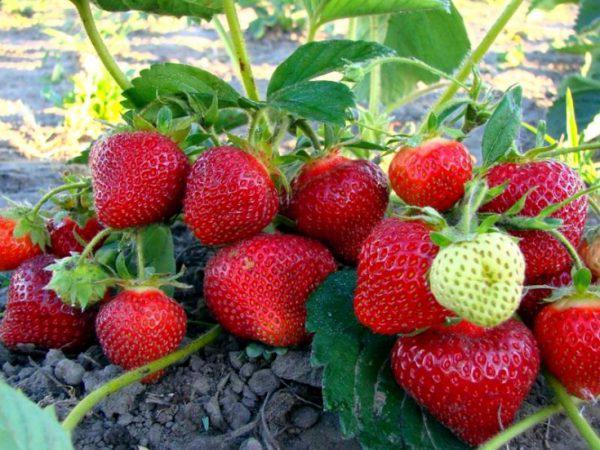
Microclimate
To obtain a constant harvest in the greenhouse, it is recommended to maintain an air temperature of + 18-25 degrees. During the period of active flowering, it is necessary to warm up the room to +21 degrees.
The optimum humidity level is 70-80%. If there is a shortage, it is recommended to spray the bushes. In case of high humidity, the greenhouses should be ventilated, otherwise the plant will infect the fungus.
Seedling container
As noted above, for planting strawberries, any containers with holes at the bottom are suitable, through which excess water is removed. For this, both ordinary pots or containers and containers made by hand from plastic pipes or bottles are used.

Further care
Strawberry care requires a constant flow of water. In this case, moisture must be avoided on the fruits and leaves. A drip irrigation system helps to achieve this, which provides for piping directly under the root of each plant.
In order for the culture to constantly bear fruit, the soil must be well moistened, and the air temperature must not exceed (not fall) the established limits. Every 10 days, it is recommended to feed the strawberries using specialized mixtures. It is also necessary, as a prevention of diseases, to spray the bushes with appropriate compositions. Affected berries and leaves should be removed immediately.
